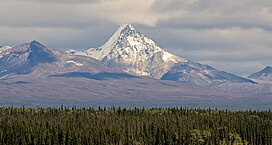| Snider Peak | |
|---|---|
 Snider Peak seen from Richardson Highway Snider Peak seen from Richardson Highway | |
| Highest point | |
| Elevation | 8,250 ft (2,510 m) |
| Prominence | 1,200 ft (370 m) |
| Parent peak | Mount Drum |
| Isolation | 3.02 mi (4.86 km) |
| Coordinates | 62°04′05″N 144°37′57″W / 62.0680193°N 144.6325298°W / 62.0680193; -144.6325298 |
| Geography | |
 | |
| Interactive map of Snider Peak | |
| Location | Wrangell-St. Elias National Park Valdez-Cordova Borough Alaska, United States |
| Parent range | Wrangell Mountains |
| Topo map | USGS Gulkana A-2 |
| Geology | |
| Rock type | Dacite |
Snider Peak is an 8,250-foot (2,515 meter) dacitic dome summit located in the Wrangell Mountains, in the U.S. state of Alaska. The peak is situated in Wrangell-St. Elias National Park and Preserve, 30 mi (48 km) east of Glennallen, and 3 mi (5 km) south of Mount Drum which is the nearest higher peak. Precipitation runoff from the mountain drains into the Dadina and Nadina Rivers which are both tributaries of the Copper River. The peak's name may have been the name of an early prospector as reported in 1903 by the US Geological Survey.
Climate
Based on the Köppen climate classification, Snider Peak is located in a subarctic climate zone with long, cold, snowy winters, and mild summers. Weather fronts coming off the Gulf of Alaska are forced upwards by the Wrangell Mountains (orographic lift), causing precipitation in the form of rainfall and snowfall. Temperatures can drop below −20 °F with wind chill factors below −30 °F. The months May through June offer the most favorable weather for viewing and climbing.
Gallery
See also
References
- ^ Snider Peak AK, listsofjohn.com
- ^ "Snider Peak". Geographic Names Information System. United States Geological Survey, United States Department of the Interior. Retrieved February 2, 2020.
- Peel, M. C.; Finlayson, B. L.; McMahon, T. A. (2007). "Updated world map of the Köppen−Geiger climate classification". Hydrol. Earth Syst. Sci. 11. ISSN 1027-5606.
External links
- Weather forecast: Snider Peak
